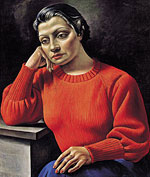La mujer del sweater rojo
1935, oil on burlap, 109 x 92.3 cm
1935, oil on burlap, 109 x 92.3 cm

The Woman in the Red Sweater is a key work in the art of Antonio Berni. Since his charcoal portraits of the 1920s he developed this genre in which, between 1934 and the end of the 1940s, he attained technical excellence and expressive intensiveness.
Under the title Figura, it was exhibited at the Salón Nacional of 1935, contest to which he would also send Desocupados, a composition of mural proportions, rejected because of its social subject. By means of his “Nuevo Realismo”, Berni replied through works of strongly critical contents to the mere formalism of certain modern trends as well as to the preaching of Mexican David Alfaro Siqueiros who, on his passing by Argentina in 1933, declared murals were an excluding modality, the very only able to carry out a revolutionary art.
Renamed by his author in 1938 as La mujer del sweater rojo, the painting inscribes in realism, together with other pictures of the same series. Yet it lacks the political entailments of pieces such as Manifestación or Chacareros, though it shares with them the stout and firm treatment of volumes and the use of burlap as support, on which Berni was experimenting then jointly with Lino Enea Spilimbergo. Additionally, an obsessive imprint, focused in details –remarkable in the textures representing the sweater’s knit or the hair– and a thorough plastic study of forms, colours, lights and shadows, detach this work and link it with the best classic tradition, mindfully learned in Europe and present in the works of the time.
The monumental aspect of the figure opposes the inward, nostalgic expression of her look, as well as the gracefulness of the pose. The design’s still exactitude, stressed by an almost merciless light which concentrates on the woman, submerges her into a rare, mysterious atmosphere, debtor of de Chirico’s metaphysic art and of surrealism, introduced by Berni himself in Argentina, in his 1932 exhibition. The artist had abandoned that tendency in order to expose the social and political crisis the country was living in that decade. Even so, letting the unconscious play a part, he endowed appearances with a new nature, in which protrude the unusual and the disturbing—elements that reality also contains.